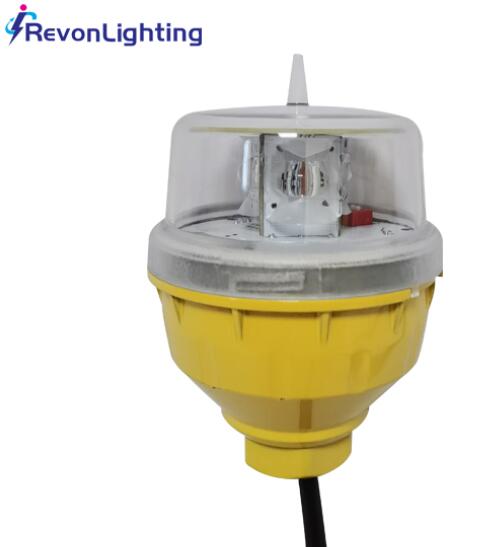Low intensity obstacle lights are an essential component in aviation and other industries where the presence of tall structures could pose a risk to air navigation. These lights are designed to mark obstacles that could otherwise be invisible to pilots during night operations or low visibility conditions. This article explores the importance of low intensity obstacle lights, their applications, regulatory standards, technological advancements, and future trends in the field.
Understanding Low Intensity Obstacle Lights
Definition and Purpose
Low intensity obstacle lights are specialized lighting devices used to mark obstacles such as towers, buildings, cranes, wind turbines, and other structures that pose a potential hazard to aviation. Their primary purpose is to ensure the visibility of these obstacles to pilots, thereby enhancing flight safety. These lights are typically used on structures that are less than 45 meters (approximately 150 feet) in height, where higher intensity lights are not necessary.
Categories and Specifications
Low intensity obstacle lights are classified into different types based on their intensity and application:

Type A: These lights emit a steady red light with an intensity of 10 candelas (cd). They are used for marking obstacles where low light levels are sufficient.
Type B: These lights also emit a steady red light but with a higher intensity of 32 candelas. They are used in areas with higher ambient light levels or where greater visibility is required.
Type E: Flashing red lights with an intensity of 32 candelas. These are used to provide additional visual cues to pilots, especially in more complex airspace environments.
Applications of Low Intensity Obstacle Lights
Aviation Safety
The most critical application of low intensity obstacle lights is in aviation safety. By marking potential hazards, these lights help prevent collisions between aircraft and structures, particularly during takeoff, landing, and low-altitude flights. They are especially important in areas near airports, heliports, and flight paths where the risk of collision is higher.
Telecommunications and Broadcasting
Towers used for telecommunications and broadcasting are often equipped with low intensity obstacle lights to ensure they are visible to pilots. These towers can be located in urban or remote areas, and the lights help to maintain safety without causing unnecessary light pollution.
Wind Energy
Wind turbines are another significant application of low intensity obstacle lights. As wind farms continue to expand, especially in rural and offshore locations, marking these tall structures is crucial to avoid accidents. The lights help pilots identify and navigate around the turbines during night operations or in poor weather conditions.
Construction and Infrastructure
During the construction of tall buildings, cranes, and other temporary structures, low intensity obstacle lights are used to mark these obstacles. This ensures that the structures are visible to aircraft, reducing the risk of accidents during the construction phase.
Regulatory Standards and Guidelines
International Standards
The International Civil Aviation Organization (ICAO) provides guidelines for the marking and lighting of obstacles to ensure uniformity and safety worldwide. According to ICAO Annex 14, low intensity obstacle lights must meet specific intensity and color requirements to be effective.
National Regulations
In addition to international guidelines, individual countries have their own regulations governing the use of obstacle lights. For instance, the Federal Aviation Administration (FAA) in the United States outlines detailed requirements for the installation and maintenance of low intensity obstacle lights in its Advisory Circulars.
Compliance and Maintenance
To ensure continuous compliance with safety standards, regular maintenance and inspections of low intensity obstacle lights are necessary. This includes checking for proper operation, cleaning lenses, and replacing faulty lights. Automated monitoring systems are increasingly used to alert operators to any issues with the lights, ensuring timely maintenance.
Technological Advancements
LED Technology
The adoption of LED technology in low intensity obstacle lights has brought significant improvements in efficiency and durability. LEDs consume less power, have a longer lifespan, and require less maintenance compared to traditional incandescent lights. Additionally, LEDs provide consistent light output and can be easily integrated with control systems.
Solar-Powered Lights
Solar-powered low intensity obstacle lights are gaining popularity, especially in remote or off-grid locations. These lights use photovoltaic panels to harness solar energy, storing it in batteries for use during nighttime. Solar-powered lights are environmentally friendly and reduce the dependency on external power sources.
Intelligent Lighting Systems
Intelligent lighting systems incorporate sensors and control mechanisms to optimize the operation of low intensity obstacle lights. These systems can adjust the light intensity based on ambient conditions, detect faults, and communicate with maintenance teams for proactive servicing. Integration with aviation safety systems ensures that the lights provide maximum benefit while minimizing energy consumption.
| Low intensity obstacle lights | type A |
| Type B | Type C |
| Type D | Type E |
Future Trends
Increased Use of Renewable Energy
As the world moves towards sustainable energy solutions, the use of renewable energy sources like solar power for low intensity obstacle lights is expected to increase. This trend will reduce the environmental impact of these lights and enhance their deployment in remote locations.
Advanced Materials and Designs
Research and development in advanced materials and designs are likely to produce more robust and efficient low intensity obstacle lights. Innovations such as self-cleaning lenses and weather-resistant materials will further reduce maintenance requirements and enhance the reliability of these lights.
Enhanced Integration with Air Traffic Control Systems
Future developments may see low intensity obstacle lights becoming more integrated with air traffic control systems. This integration would allow for real-time monitoring and management of obstacle lights, improving safety and operational efficiency.
Conclusion
Low intensity obstacle lights play a vital role in ensuring the safety of aviation and other industries where tall structures are present. With ongoing advancements in technology and increasing emphasis on sustainability, these lights are becoming more efficient, reliable, and environmentally friendly. By adhering to regulatory standards and leveraging new technologies, we can continue to enhance the safety and efficiency of low intensity obstacle lights, making our skies safer for all.